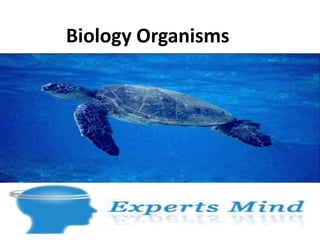Biology organisms
•Download as PPTX, PDF•
1 like•375 views
www.expertsmind.com/topic/biology/microbiology-92241.aspx
Report
Share
Report
Share

Recommended
Recommended
More Related Content
What's hot
What's hot (20)
Similar to Biology organisms
Similar to Biology organisms (20)
Biology lecture 1 and 2_e6c1908877387bfcb9829159160b7c89.pptx

Biology lecture 1 and 2_e6c1908877387bfcb9829159160b7c89.pptx
Bio 101 chapter 1- the scientific study of life part 1 narrated

Bio 101 chapter 1- the scientific study of life part 1 narrated
Cells (The basic unit of life) and Functions. pptx

Cells (The basic unit of life) and Functions. pptx
More from Expertsmind IT Education Pvt Ltd.
More from Expertsmind IT Education Pvt Ltd. (20)
Recently uploaded
Enterprise Knowledge’s Urmi Majumder, Principal Data Architecture Consultant, and Fernando Aguilar Islas, Senior Data Science Consultant, presented "Driving Behavioral Change for Information Management through Data-Driven Green Strategy" on March 27, 2024 at Enterprise Data World (EDW) in Orlando, Florida.
In this presentation, Urmi and Fernando discussed a case study describing how the information management division in a large supply chain organization drove user behavior change through awareness of the carbon footprint of their duplicated and near-duplicated content, identified via advanced data analytics. Check out their presentation to gain valuable perspectives on utilizing data-driven strategies to influence positive behavioral shifts and support sustainability initiatives within your organization.
In this session, participants gained answers to the following questions:
- What is a Green Information Management (IM) Strategy, and why should you have one?
- How can Artificial Intelligence (AI) and Machine Learning (ML) support your Green IM Strategy through content deduplication?
- How can an organization use insights into their data to influence employee behavior for IM?
- How can you reap additional benefits from content reduction that go beyond Green IM?
Driving Behavioral Change for Information Management through Data-Driven Gree...

Driving Behavioral Change for Information Management through Data-Driven Gree...Enterprise Knowledge
Recently uploaded (20)
How to Troubleshoot Apps for the Modern Connected Worker

How to Troubleshoot Apps for the Modern Connected Worker
Axa Assurance Maroc - Insurer Innovation Award 2024

Axa Assurance Maroc - Insurer Innovation Award 2024
Tech Trends Report 2024 Future Today Institute.pdf

Tech Trends Report 2024 Future Today Institute.pdf
Handwritten Text Recognition for manuscripts and early printed texts

Handwritten Text Recognition for manuscripts and early printed texts
Bajaj Allianz Life Insurance Company - Insurer Innovation Award 2024

Bajaj Allianz Life Insurance Company - Insurer Innovation Award 2024
How to Troubleshoot Apps for the Modern Connected Worker

How to Troubleshoot Apps for the Modern Connected Worker
08448380779 Call Girls In Greater Kailash - I Women Seeking Men

08448380779 Call Girls In Greater Kailash - I Women Seeking Men
IAC 2024 - IA Fast Track to Search Focused AI Solutions

IAC 2024 - IA Fast Track to Search Focused AI Solutions
Driving Behavioral Change for Information Management through Data-Driven Gree...

Driving Behavioral Change for Information Management through Data-Driven Gree...
The Role of Taxonomy and Ontology in Semantic Layers - Heather Hedden.pdf

The Role of Taxonomy and Ontology in Semantic Layers - Heather Hedden.pdf
Strategies for Landing an Oracle DBA Job as a Fresher

Strategies for Landing an Oracle DBA Job as a Fresher
Apidays Singapore 2024 - Building Digital Trust in a Digital Economy by Veron...

Apidays Singapore 2024 - Building Digital Trust in a Digital Economy by Veron...
Biology organisms
- 2. Populations
- 3. Ecosystems
- 5. Life’s Levels of Organization The world of life shows levels of organization, from the simple to the complex, which extend through: cells (made of?) tissues & organs organisms populations communities ecosystems the biosphere
- 6. Reductionist Principle The study of life is complex so • Chemicals broken down into compartments • Cells Within a cell • Tissues Among cells in an organ • Organs Among the organ systems in an • Systems organism • Organism Between organisms and the • Population environment • Community Among individuals in a • Ecosystem population Between species
- 7. The Cell, Structure & Function What is a cell ? (The cell is the Structural and functional unit of all living organisms) Two Types of cells: 1- Prokaryotic cells: cells without a nuclear membrane The DNA is free in the cytoplasm: Bacteria and Cyanobacteria 2- Eukaryotic cells: has a proper nucleus with a nuclear membrane: plants, animals ….
- 8. What does this figure describe? What else “flows” from producers to consumers to decomposers?
- 9. I. Characteristics of Living Organisms A. Living things share the following characteristics: 1. Living things are made up of units called cells. a. Remember that cells are like little packages f chemical reactions. b. Life processes only occur as a result of chemical reactions in cells (life is chemistry) 2. Living things reproduce. 3. Living things are based on a universal genetic code. (Contain DNA)
- 10. 4. Living things grow and develop. 5. Living things obtain and use materials and energy. (Eat or Photosynthesize) 6. Living things respond to their environment. 7. Living things maintain a stable internal environment. (Maintain Homeostasis) a. Homeo=Same Stasis= Status 8. Taken as a group, living things change over time. (Evolve)
